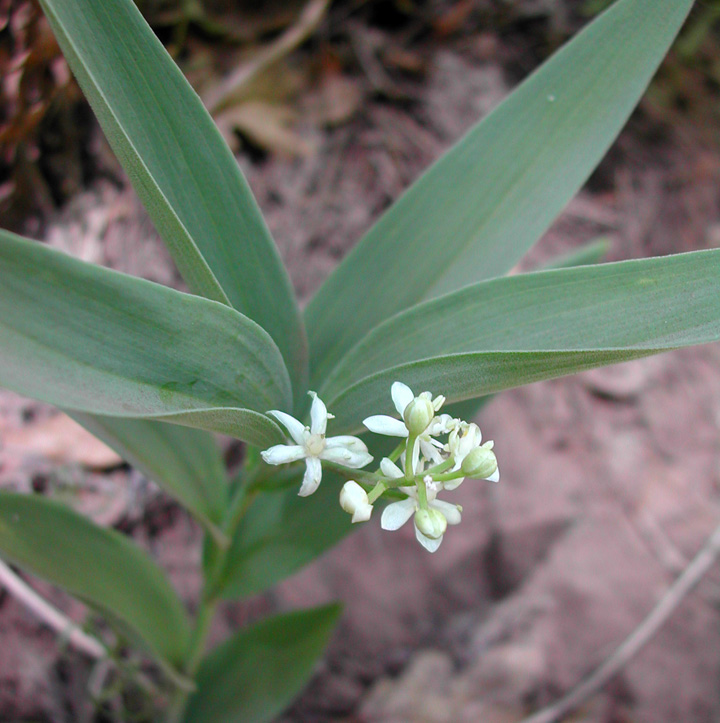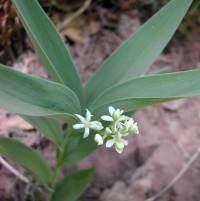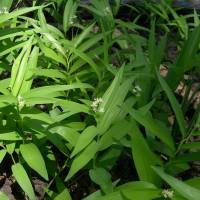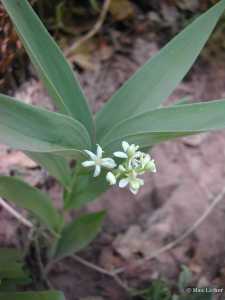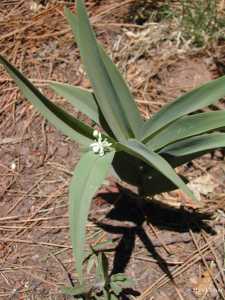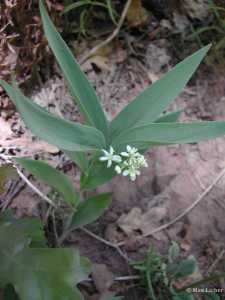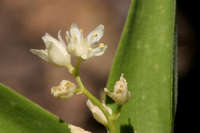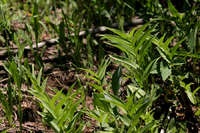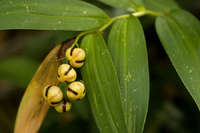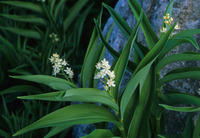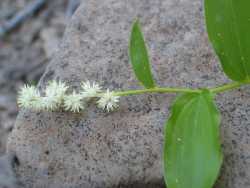Plants terrestrial, 15-45 cm. Rhizomes sympodial, proliferatively spreading, narrow-cylindrical, units 15-60 cm × 3-4.5 mm, roots scattered over surfaces. Stems erect, 2.5-5 dm × 2-3.5 mm. Leaves 8-11, sessile, clasping; blade ovate-elliptic to lanceolate, 5-6 × 2.5-3.5 cm; base rounded; apex acute. Inflorescences racemose, simple, 6-15-flowered. Flowers 1 per node, 3-merous; tepals conspicuous, 4-5 × 1.5-2 mm; filaments 1.2-1.5 mm; anthers 0.6-0.8 mm; ovary globose to cylindrical, ca. 1 mm wide; style 1.3-1.8 mm; stigma obscurely 3-lobed; pedicel 6-12 × 0.8-1 mm. Berries green with black stripes along median carpel vein when young, maturing to red, globose, 4-6 mm diam. Seeds 1-6, globose, 2.5-3 mm. 2n = 36.
Flowering mid or late spring. Sand dunes, marginal woodlands, oak openings; 0--3200 m; Alta., B.C., Man., N.B., Nfld. and Labr. (Nfld.), N.W.T., N.S., Ont., P.E.I., Que., Sask., Yukon; Alaska, Ariz., Calif., Colo., Conn., Del., D.C., Idaho, Ill., Ind., Iowa, Kans., Ky., Maine, Md., Mass., Mich., Minn., Mo., Mont., Nebr., Nev., N.H., N.J., N.Mex., N.Y., N.Dak., Ohio, Okla., Oreg., Pa., R.I., S.Dak., Tenn., Utah, Vt., Va., Wash., W.Va., Wis., Wyo.; disjunct in nw Mexico.
Perennial herb with a long, creeping rhizome flowering stem 20 cm - 0.6 m long
Leaves: alternate, six to eleven, spreading or ascending, usually folded, stalkless, somewhat clasping, 6 - 15 cm long, 2 - 5 cm wide, lance-shaped with a rounded base and pointed tip, finely hairy beneath.
Inflorescence: a 2 - 5 cm long, terminal, nearly stalkless cluster (raceme) of six to fifteen flowers on an upright or sometimes ascending stem.
Flowers: white, 8 - 10 mm wide, star-shaped, with six distinct, spreading tepals. Stamens six.
Fruit: a one- to two-seeded spherical berry, from green with dark stripes to dark red, 6 - 10 mm wide.
Similar species: Plants in the genus Maianthemum (false Solomon's seal) are similar to those in the genus Polygonatum (true Solomon's seal) but differ in where the flowers grow. True Solomon's seal has flowers that grow and hang along the stem, while the flowers of false Solomon's seal grow in clusters at the end of the stem. The similar Maianthemum racemosum differs by having flowers that grow in a branched cluster called a panicle. Maianthemum trifolium is also similar but has one to four hairless leaves and a long-stalked flower cluster.
Flowering: mid-April to mid-June
Habitat and ecology: Common in a variety of habitats, including woodlands, sandy Black Oak savannas, prairies, calcareous springy areas, and in the shrub zone on dunes facing Lake Michigan.
Occurence in the Chicago region: native
Etymology: Maianthemum comes from the Greek words maios, meaning May, and anthemon, meaning blossom. Stellatum means star-like.
Author: The Morton Arboretum
infrequent to frequent in the northern half of the state and rare or absent from the southern counties. It prefers moist soil and is most often found on moist slopes and springy banks but is also found on dry banks, in black and white oak woods, and is most abundant on the sand dunes about Lake Michigan. The lower surface of the leaves is very variable, ranging from glabrous to densely short-pubescent. Two varieties of this species have been described and we have both of them, but I think, judging from the descriptions, they are only ecological forms.
Duration: Perennial
Nativity: Native
Lifeform: Forb/Herb
General: Stems erect to arching and glabrous from a slender rhizome, these narrow cylindrical, 20-50 cm tall.
Leaves: Sessile and clasping, pubescent to glabrous beneath, lanceolate to ovate elliptic, 5-9 per stem, 5-6 cm long, glabrous above, minutely puberulent to pubescent below, the base rounded and the apex acute.
Flowers: Racemose and simple these with 15 or fewer flowers, the flowers one per node and 3-merous, the tepals 4-7 mm long.
Fruits: Green with black stripes and mottled when young, maturing red, globose and 4-6 mm in diameter.
Ecology: Found in damp woods and partial shade from woodlands up through high elevation forests from 5,000-10,000 ft (1524-3048 m), flowers from May-July.
Distribution: Ranges north throughout the United States to Canada and to Alaska, south into northwest Mexico where FNA notes a disjunct.
Notes: This species can be distinguished by the more clearly racemose inflorescence, where the other species in the region has a delicate paniculate shape.
Ethnobotany: Used to stimulate the stomach and for stomach troubles, as a blood cleanser, a general systemic cleanser, applied externally for rheumatism, used as an eye wash, for menstrual disorders and as a contraceptive, taken for colds, and used as a general tonic. The berries were eaten widely.
Etymology: Maianthemum is from Greek for May flower, while stellatum means star-like.
Synonyms: Numerous, see Tropicos
Editor: SBuckley, 2011
Stem ascending or usually erect, 2-6 dm, finely hairy or glabrous; lvs spreading or more often strongly ascending, usually folded, sessile and somewhat clasping, lanceolate or lance- oblong, 6-15 נ2-5 cm, gradually tapering to the acute tip, finely hairy beneath; raceme short-peduncled or subsessile, 2-5 cm, with few-several fls 8-10 mm wide; fr 6-10 mm, at first green with blackish stripes, becoming uniformly dark red; 2n=36. Moist, especially sandy soil of woods, shores, and prairies; Nf. to B.C., s. to N.J., Va., Ind., Mo., and Calif. May, June. (Maianthemum s.; Vagnera s.) Coastal plants of se. Can., s. reputedly to Conn., tend to have fleshy, crowded, imbricate, obtuse lvs, and have been segregated as var. crassa Victorin.
Gleason, Henry A. & Cronquist, Arthur J. 1991. Manual of vascular plants of northeastern United States and adjacent Canada. lxxv + 910 pp.
©The New York Botanical Garden. All rights reserved. Used by permission.


